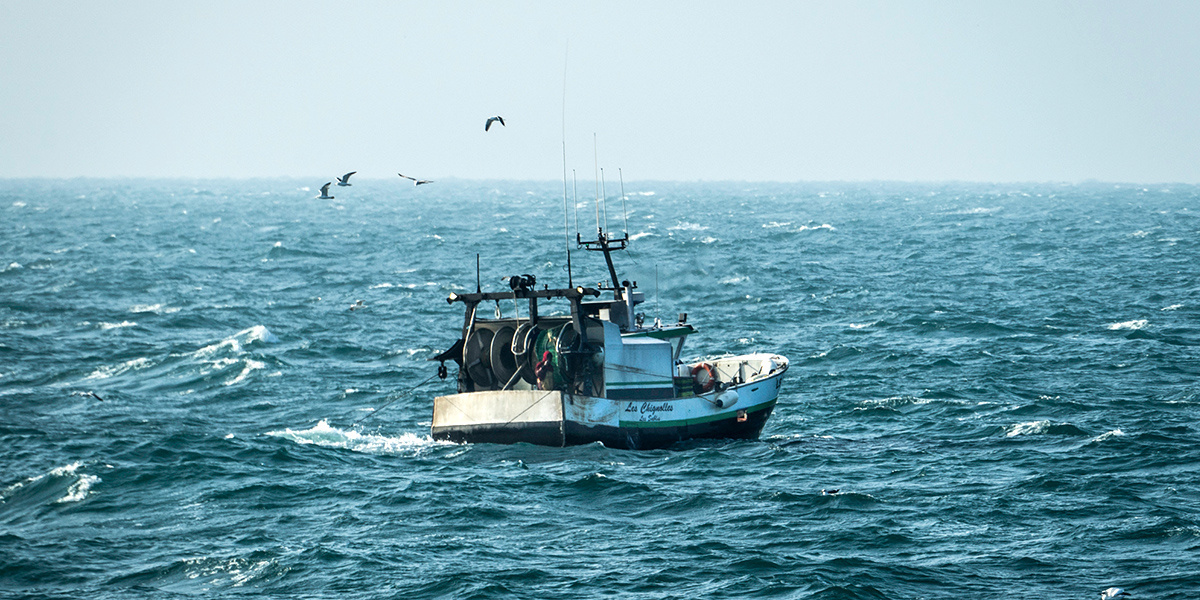

From January through March, an average of 6,000 dolphins are killed each year on France’s west coast by large industrial trawlers and vessels fishing in pairs (nets dragged between two trawlers). That number could be as high as 10,000, according to the Pélagis Observatory, based in La Rochelle. That’s more than the number of dolphins killed each year in the Danish Faroe Islands and The Cove in Taiji, Japan, combined.
These vessels fish mainly for sea bass, targeting spawning grounds during the breeding season. This practice not only threatens sea bass populations, but is also deadly to dolphins trapped and drowned in the nets as by-catch. While on patrol in the Rochebonne plateau this weekend, Sea Shepherd‘s vessel the Bob Barker filmed the trawlers Jeremi Simon and Promethée pulling up their nets with two dolphins trapped inside.
One of the dolphins seemed already drowned, but the other, still alive, emitted whistles of distress that can be heard on the video. Instead of discarding the dolphins back into the water in front of the Sea Shepherd crew, the two dolphins were brought aboard one of the two vessels. This macabre scene is repeated every night, all year round along the French coast, peaking between January and March.
Will Dolphins Soon Disappear Completely From the French Coastal Waters?
The Pélagis Observatory has been publishing alarming reports about the declining dolphin populations for several years, without being heard. In a 2016 report signed by the French National Center for Scientific Research (CNRS), Pélagis and the University of La Rochelle, it is clearly stated that the mortality inflicted on dolphins by fishing vessels jeopardizes the survival of the population in the medium term.
Marine mammals are particularly vulnerable. With low fertility rates and a high sensitivity to chemical and plastic pollution, they also face food scarcity due to overfishing. It is therefore urgent to take immediate measures to protect them. However, the French State has not yet responded to all the scientists’ warnings on the subject, and the fishermen involved are taking advantage of the general public’s ignorance.
The Hellish Journey of Captured Dolphins
Dolphins that typically live alongside sea bass are caught in fishing nets that capture everything in their path indiscriminately. From there follows an agonizing death as the trapped dolphins are drowned in the net. Any dolphins that are pulled up alive usually die from wounds inflicted by fishermen onboard the vessels. The corpses regularly washing up on French beaches show fractures, broken tails and flippers, and deep incisions cut into their skin by the nets.
Intentionally Opaque Reporting of By-Catch Numbers That Are Hardly ‘Incidental’
“By-catch” is the nondescript term used to describe the hecatomb of dolphins taking place each year along French coasts, a slaughter that takes place in total and tightly-guarded opacity.
In fact, although the law requires fishermen to declare their dolphin catches, in practice the State has not designated any regulatory body to receive this data. This vacuum prevents any monitoring of the mortality inflicted on marine mammals by trawlers. The Pélagis Observatory is qualified and capable of receiving this data but has not obtained the authorization to do so.
Furthermore, no funds have been allocated to the implementation of more selective fishing techniques, even though these funds exist. Industrial fishing is heavily subsidized in France, but reducing dolphin mortality is not one of the priorities of the State’s fisheries policy.
How Can the Dolphins Be Saved?
Sea Shepherd France President Lamya Essemlali has called on the French State to:
1. Prohibit trawling vessels from fishing in sea bass spawning grounds. France gives authorizations for particularly destructive fishing in sensitive areas, but does not apply adequate surveillance measures in parallel.
2. Establish better monitoring of fisheries and effectively prevent the sale of juvenile fish. France has already been fined several million euros for its tolerance to the sale of undersized fish, banned by the European Union, with the obvious aim of preserving populations.
3. Finally, designate an organization (like Pélagis) to receive data related to dolphin by-catch in fishing gear.
What the General Public Can Do
1. Eat less fish.
2. Avoid undersized fish completely.
3. Boycott fish from trawling vessels, sticking exclusively to line-caught fish.

 233k
233k  41k
41k  Subscribe
Subscribe 